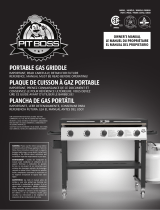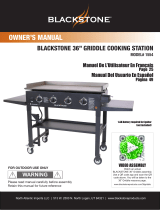
ENGLISH
3
5. Parts of the barbecue may be very hot, and serious injury may occur. Keep young children and pets away while in use. Do
not touch hot surfaces. Use heat-resistant gloves, long-handled tongs, or cooking mitts at all times, since the griddle will
become very hot.
6. Never use the griddle without the grease cup installed and hung under the firebox. Without the grease cup, hot grease and
debris could leak downward and produce a fire hazard.
7. Do not obstruct the flow of combustion and ventilation air to this appliance. Keep the burner tube and portholes clean and
free from debris. Clean before use. Regular care and maintenance is required to prolong the lifespan of your unit.
8. Always check for gas leaks when you connect and disconnect the regulator to the gas cylinder, especially after a period of
storage (for example, over winter). Check all connections for leaks with a soapy water solution and brush. Never use an open
flame to check for leaks.
9. Clean and inspect the gas regulator before each use of the outdoor cooking gas appliance. Replace the gas regulator prior
to being used if there is evidence of excessive abrasion or wear. Use only the gas regulator assembly that has been supplied
with this gas griddle. Do not use a regulator from another manufacturer.
Do not use lava rock, wood chunks, charcoal, lighter fluid, alcohol or other similar chemicals for lighting or
relighting. Keep all such substances and liquid away from appliance when in use.
10. Operate this appliance using liquefied petroleum only, which is also specified on the rating label on the unit. Do not attempt
to operate your griddle on other gases. Do not attempt to convert this LP unit to natural gas. Failure to follow this warning
could lead to fire, bodily harm, and will void your warranty.
PROPANE GAS WARNINGS
1. Ensure the gas cylinder is purchased by a reputable supplier. An incorrectly filled or an overfilled LP tank can be dangerous.
The overfilled condition combined with the warming of the LP gas tank (a hot summer day, tank left in the sun, etc.) can
cause LP gas to be released since the temperature increase causes gas to expand. Gas released from the cylinder is flammable
and can be explosive.
2. Do not use an LP gas cylinder if it has a damaged valve or shows signs of dents, gouges, bulges, fire damage, corrosion,
leakage, excessive rust, or other forms of visual external damage; it may be hazardous and should be checked immediately
by a liquid propane supplier.
If you see, smell, or hear the hiss of gas escaping from the cylinder, do not attempt to light appliance.
Extinguish any open flame. Disconnect from fuel supply.
3. Do not connect or disconnect the gas cylinder while the unit is in use or is still hot. When griddle is not in use, ensure
regulator knob is turned to OFF and disconnect the gas cylinder. Never move or transport the unit while the gas cylinder is
attached. Do not store a spare LP gas cylinder under or near the appliance.
4. Cylinders must be stored outdoors out of reach of children and must not be stored in a building, garage, or any other
enclosure area.
CARBON MONOXIDE (“ ”)
Always use a gas appliance outdoors in an open area with good ventilation to avoid breathing toxic fumes from combustion or
leaking gas. Carbon monoxide is a colorless, odorless, tasteless gas produced by burning gas, wood, propane, charcoal or other
fuel. Carbon monoxide reduces the blood’s ability to carry oxygen. Low blood oxygen levels can result in headaches, dizziness,
weakness, nausea, vomiting, sleepiness, confusion, loss of consciousness or death. Follow these guidelines to prevent this
colorless, odorless gas from poisoning you, your family, or others:
• See a doctor if you or others develop cold or flu-like symptoms while cooking or in the vicinity of the appliance. Carbon
monoxide poisoning, which can easily be mistaken for a cold or flu, is often detected too late.
• Alcohol consumption and drug use increase the effects of carbon monoxide poisoning.
Carbon monoxide is especially toxic to mother and child during pregnancy, infants, the elderly, smokers, and people with blood
or circulatory system problems, such as anemia, or heart disease.

























